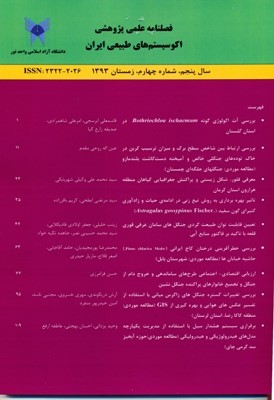برقراری سیستم هشدار سیل با استفاده از مدیریت یکپارچه مدلهای هیدرولوژیکی و هیدرولیکی (مطالعه موردی:حوزه آبخیز سد گرمی چای )
محورهای موضوعی : جنگلداریوحید یزدانی 1 , احسان بهجتی 2 , عاطفه ارفع 3
1 - دکتری مهندسی آب، معاون پژوهشی پژوهشکده آب و خاک کاوش پی مشهد، مشهد، ایران
2 - کارشناس ارشد سازههای آبی، دانشگاه آزاد اسلامی واحد فردوس، فردوس، ایران
3 - دانشجوی کارشناسی ارشد سازههای آبی، دانشگاه فردوسی مشهد، مشهد، ایران
کلید واژه: ضریب سیلخیزی, مدل بارش- رواناب, هشدار سیل, سد گرمی چای,
چکیده مقاله :
چکیده بررسی هرچه بیشتر در مورد سیلاب از نقطه نظرهای مختلف هیدرومتئولوژی و سیستم حوزه های آبخیز و تحلیل مدل های بارش- رواناب و تعیین پهنه های سیل گیر با توجه به شرایط هیدرولوژیکی و هیدرولیکی حوضه، نه تنها از نظر مالی و حقوقی بلکه برای پیش بینی و کمک به سیستم های هشدار دهنده سیل راه گشا می باشد. هدف از پژوهش حاضر، ارائه راهکاری مناسب به منظور برقراری سیستم هشدار سیل با استفاده از مدل هیدرولوژیکی HEC-HMS و مدل هیدرولیکی HEC-RAS در حوضه سد گرمی چای می باشد. در مطالعات هیدرولوژی پس از بازسازی دادهها، آنالیز فرکانس سیلابهای حداکثر یک روزه در محل ایستگاهها صورت گرفته است که توزیع منتخب برای همه ایستگاهها، توزیع نرمال سه پارامتری بود. با اعمال نسبت سیلاب حداکثر لحظهای به سیلاب حداکثر یکروزه، مقادیر سیلاب حداکثر لحظهای با دوره بازگشتهای مختلف رودخانه گرمیچای در محل سد گرمیچای محاسبه گردید. طغیان های رودخانه گرمی چای در شرایط موجود بخصوص در دوره بازگشت های نسبتاً بالا باعث غرقابی شدن قسمت زیادی از کنار رودخانه با توجه به شیب کم اراضی منتهی به رودخانه می شود. محاسبات حاصل از اجرای مدل نشان داد که نحوه مشارکت زیرحوضهها در سیل خروجی لزوماً متناسب با دبی اوج زیرحوضهها نبوده و زیرحوضههای با دبی اوج بالا ضرورتاً تأثیر بیشتری در سیل خروجی حوضه ندارند. بر اساس نتایج بدست آمده زمان پیش هشدار در سد گرمی چای در گروه C (بیش از 3 تا 6 ساعت) طبقه بندی گردید.
Abstract Study more about the different points of view Hydrometolojy flood drainage systems and catchment model analysis of rainfall, runoff and flood designated area according to hydrological and hydraulic retention basins, not only financially, but also the legal and the pre warning system to predict and help the decoder is represents the flooding. The purpose of this study is to provide an appropriate mechanism to establish flood warning system hydrological model HEC-HMS and HEC-RAS hydraulic model for the catchment dam is Garmi Chay. After restructuring the data in hydrological studies, flood frequency analysis, maximum a day at selected stations has been distributed to all stations, the three-parameter normal distribution. Applying the ratio of the maximum instantaneous flood peak flood one day, maximum instantaneous flood levels with return periods Garmi Chay River at the dam site Garmi Chay was calculated. The model calculations show that the contribution of the sub-basin outlet flood peak flows sub watershed is not necessarily proportional to the sub basin with high peak flows are not necessarily more effective flood basin outlet. Based on the results pre alerts dam hot tea in Group C (no more than 3 to 6 hours) floor was packed.
References
1-Amir Ahmadi, A.B., A.B. Behnamfar, M. Ebrahimi, 1390. Micro-zoning of flood risk in the range of Sabzavar in the development of sustainable cities. Journal of Environmental logistics. 7th year, Issue 16, pp. 17-32
2-Azari, H., A.A. Matkan, A.R. Shakiba, H. Purali, 1388. Simulation and flood warning with synthesis pilot models in GIS and rainfall estimates through remote sensing. Iranian Journal of Geology. 3rd years, Issue 9, pp. 39-51.
3-Hoseynzade, M.M., S. Biranvand, A. Hoseyni Asl, H. Saduq, 1392. Simulation Kashkan flood river. Iranian Journal of Remote Sensing and GIS, Issue 17, pp. 71-84.
4-Roshan, H., Q.Vahabzade, K. Soleymani, R. Farhadi, 1392. Simulate the hydraulic behavior of the river using HEC-RAS model in GIS (Case study: Bashar River, Kohgiluyeh and Boyer Ahmad State). Journal of Watershed Management, Issue 7, pp. 70-84.
5-Farahmand Kenari, Sh., M. Rayyni, K. Soleymani, 1390. Analysis of the Babol River with hydraulic model HEC-RAS using GIS and provide patterns in flood management, Watershed management Journal, 2nd year, Issue 3, pp. 19-33.
6-Qobadian, R., 1387. Simulate hydraulic flood routing in Gharehsou river using numerical unsteady flow equations. 7th Conference of hydraulic, 21 to 23 November, the utilities industry University of martyr Abbaspoor.
7-Nuri, F., H. Behmanesh, B.M. Mohamadnezhad, H. Rezayi, 1391. Evaluation WMS/HEC-HMS Model in forecast of Qorveh basin flood, Journal of soil and water conservation, Vol. 19, Issue 4, pp. 201-210.
8-Vahabi, J., 1385. Flood risk mapping using hydrological and hydraulic models (case study Taleqan), the research and construction Journal, Issue 71, pp. 33-41.
9-Garambois, P.A., H.K. Larnier, D. Roux, D. Labat, 2014. Analysis of flash flood-triggering rainfall for a process-oriented hydrological model, Atmospheric Research, Vol. 137, Issue14, pp. 14-24.
10-Knebl, M.R., Z.L. Yang, K. Hutchison, D.R. Maidment, 2005. Regional scale flood modeling using NEXRAD, rainfall, GIS, and HEC-HMS\RAS: A Case Study for the San Antonio River Basin, summer 2002 storm event. J. Environ. Manage. 75: 325-336
11- Kafle, T.P., M.K. Hazarica, K.G. Shresth, K. Prathumchai, L. Samarakon, 2006. Integration of remote sensing and GIS with flood simulation model for flood hazard mapping in the Bagmati river, Nepal. J. Environment management. 13:8. 45-57.
12-Sholtes, J., 2009. Hydraulic analysis of stream restoration on flood wave propagation. A thesis submitted to the faculty of the University of North Carolina at Chapel Hill.
13-Stephen, R., 2002. Hydrologic investigation by the USGS following the 1996 and 1997 flood in the upper Yellow stone river, Montana, American Water Resources Association, Annual Montana Section Meeting, Vol. 14, Issue8, pp: 1-18.
14-Tsung, Y., Yi-Ting, Y., and Hung-Chi, K., 19 August 2013, Improvement of watershed flood forecasting by typhoon rainfall climate model with an ANN-based southwest monsoon rainfall enhancement, Journal of Hydrology, In Press, Corrected Proof.


